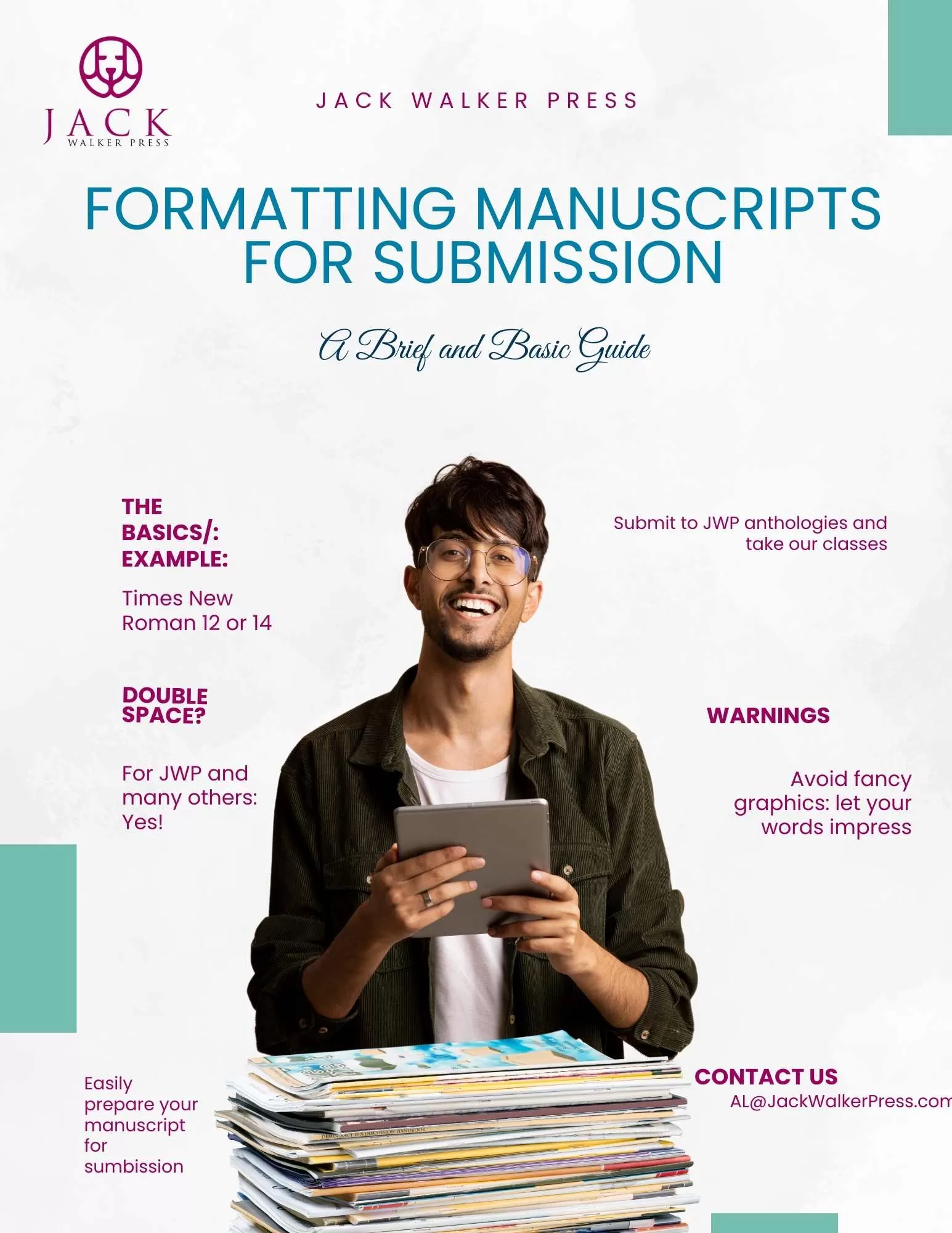Format Your Essay or Article for Submission.
Use this guide to format your manuscript for submission to JWP anthologies. Free Pdf guide also available.
Formatting your Article or Essay for Submission: A Step-by-Step Guide
Are you an aspiring writer eager to get your work out into the world? Submitting essays or articles for publication can be an exciting yet daunting task. However, with the right guidance, you can navigate the submission process with confidence and increase your chances of success. Before you consider formatting manuscripts, essays, and articles consider ways to write a great personal essay. If you'd enjoy brief downloadable PDF with the essentials of formatting: Download it here.
Formatting Manuscripts
Let's discuss the standard formatting requirements for your essay or article. These submissions formatting guidelines apply to Jack Walker Press and many other publishers. Always conform to the submission requirements of a publisher to increase your odds of staying out of the rejection pile. Following these guidelines will help ensure that your submission looks polished and professional:
- Document Settings: Use a word processing software like Microsoft Word or Google Docs. Set the font to Times New Roman, size 12 or 14.
- Margins: Set one-inch margins on all sides of the page.
- Spacing: Double-space your entire document. Do not include an extra line between paragraphs.
- Paragraph Indentation: Indent most paragraphs using the tab key, except for the first paragraph of each section or after a heading.
- Header: Include a header on each page with the essay or article's title and your name.
- Pagination: Paginate your document, typically in the upper right-hand corner, with your last name and the page number.
- Title and Author Information: Center the title of your essay or article in the middle of the page. Your name, address, phone number, and email address should be aligned to the upper left corner of the first page.
Crafting Your Cover Letter
While the formatting of your submission document is important, don't overlook the significance of your cover letter. Whether you're submitting via email or an online submission manager, your cover letter serves as your introduction to the editor. Here are some key points to include in your cover letter:
- Brief Introduction: Start with a polite greeting and a concise introduction of yourself. Mention any relevant credentials or previous publications if applicable.
- Use Names: Use the correct spelling and title of the editor and do name drop if you have some association. For example mention that you met at a writing conference or that another agent or editor referred you --if this is a case. If you have any relationships or experience, you may even state something specific about the place your are submitting that relates to your appreciation of the publisher or editor. When people submitted to the JWP Friends anthology, some of them mentioned having enjoyed the previous Corners anthology and even mentioned a essay or two and a few words about why they appreciated the work. This helps create an immediate kindship. It doesn't mean the work will definitely be accepted, it does mean it's likely to be given a reading where we hope work is a fit.
- Title and Word Count: Clearly state the title of your essay or article along with the word count.
- Offered Rights: Specify the rights you are offering for publication. For instance, are you offering first North American serial rights, electronic rights, or all rights? Be clear about what you're comfortable granting.
- Submission Date: Include the date of submission.
- Submission Specifics: If you're submitting to a particular publication, follow their specific guidelines meticulously. Different publishers may have varying requirements regarding formatting, submission method, and accompanying materials.
Following Publisher Guidelines: The Case of Jack Walker Press
When submitting your work to a specific publisher like Jack Walker Press, it's imperative to thoroughly review and adhere to their submission guidelines. Each publisher has its own set of requirements and preferences, which can significantly impact your submission's chances of being accepted.
For Jack Walker Press, here are some guidelines to keep in mind:
- Formatting: Ensure that your submission adheres to the formatting standards outlined earlier in this guide. Pay close attention to font, spacing, and margin requirements.
- Cover Letter: As discussed earlier, your cover letter should be concise, professional, and tailored to Jack Walker Press's submission guidelines. The cover letter in our case can be the email to which you attach your submission essay.
- Word Count: Check if Jack Walker Press has specific word count limitations for submissions 500-400 words. Adjust your essay or article accordingly to meet their requirements.
- Rights: Be clear about the rights you are offering to Jack Walker Press. Review their rights policies to ensure alignment with your preferences. Jack Walker Press accepts reprints when you have the rights to reprint.
- Submission Method: Follow the specified submission method outlined by Jack Walker Press. Whether it's via email or an online submission portal, ensure that you follow the instructions provided. For JWP, sign up to LitFriends to have access to our submission portals.
Download your Free Guide
Submitting your essay or article for publication can be a rewarding experience, but it requires attention to detail and adherence to guidelines. It's not difficult; it's specific. By following the formatting tips outlined in this brief guide and paying close attention to publisher-specific requirements, you can increase your chances of success in the competitive world of writing and publishing. So, polish your work, craft a compelling cover letter, and submit your masterpiece with confidence!



